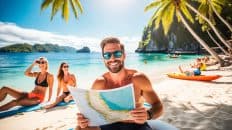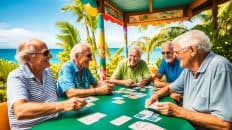Have you ever dreamed of living in a tropical paradise? The Philippines offers a vibrant expat life that combines rich culture, affordable cost of living, and stunning natural beauty. From retirees seeking a peaceful retreat to young professionals in search of adventure, the Philippines has something for everyone. But what exactly makes this archipelago a top choice for expats? Let’s dive deeper into the unique experience of living in the Philippines and discover the reasons behind its allure.
Key Takeaways:
- The Philippines attracts expats with its rich culture, affordable cost of living, and tropical paradise setting.
- Transportation options in the Philippines include public transport, driving, taxis, and ride-hailing apps like Grab.
- The cost of living in the Philippines can be tailored to fit any budget, offering affordable dining, accommodation, and transportation.
- Accommodation options in the Philippines range from condos to guest houses and small hotels, catering to different preferences and budgets.
- Expats can enjoy a mix of Filipino and international cuisines, with Japanese restaurants, Taiwanese bubble tea shops, and food delivery services available.
Getting Around in the Philippines: Transportation Options for Expats
When it comes to getting around in the Philippines, expats have a variety of transportation options to choose from. Whether you prefer public transport, driving, or relying on taxis and ride-hailing apps, there are convenient ways to navigate the bustling cities and explore the beautiful islands.
Public Transport in the Philippines
Public transport in the Philippines can be a bit crowded and overwhelming, especially during peak hours. However, it is an affordable option for those who want to experience local commuting. The national railway service covers most of the country, offering a convenient way to travel between different regions.
In addition to trains, buses and jeepneys are popular modes of transport in the Philippines. Jeepneys are traditional, jeep-like vehicles that can often be found on major roads and provide a unique cultural experience for expats.
Driving and Taxis
Many expats choose to drive in the Philippines, as it gives them the flexibility and convenience to explore at their own pace. However, it’s important to note that driving in the Philippines can be quite chaotic, with drivers often ignoring traffic signals. Expats planning to drive for more than 90 days need to obtain a local driver’s license.
If you prefer not to drive, taxis are readily available in most cities and towns. They are metered, making it easier to keep track of fares and ensure a fair deal. Ride-hailing apps like Grab are also popular among both locals and expats, providing a convenient way to book and pay for rides.
Boats, Ferries, and Philippine Airlines
Given the geographical layout of the Philippines, boats and ferries are common modes of transport, especially for traveling between islands. This is particularly true for popular tourist destinations like Palawan and Boracay. Boats and ferries offer scenic and relaxing journeys, allowing you to enjoy the beauty of the archipelago.
For those who prefer to travel by air, Philippine Airlines is the country’s national carrier and offers domestic flights between various destinations in the Philippines. This allows for easy and convenient travel, especially when covering long distances or visiting remote islands.
Comparison of Transportation Options in the Philippines
| Transportation Option | Advantages | Disadvantages |
|---|---|---|
| Public Transport | Affordable; covers most regions; cultural experience with jeepneys | Crowded during peak hours |
| Driving | Flexibility; convenience; ability to explore at your own pace | Chaotic traffic; erratic driving behavior |
| Taxis and Ride-hailing Apps | Readily available; metered fares; convenient booking and payment | Traffic congestion; availability during busy periods |
| Boats and Ferries | Scenic; relaxing; access to remote islands | Weather-dependent; limited schedules |
| Philippine Airlines | Easier travel between islands; convenient for long distances | Higher fares compared to other modes of transport |
With a variety of transportation options available, getting around in the Philippines as an expat is both exciting and accessible. Whether you choose to embrace the charm of public transport, navigate the roads on your own, or take advantage of convenient taxi services and ride-hailing apps, you’ll find that exploring the Philippines is an adventure in itself.
Cost of Living in the Philippines: Affordable Living for Expats
Manila Rent Prices
Dining Out in the Philippines
One of the joys of living in the Philippines is the opportunity to explore its diverse culinary scene. Dining out at a nice restaurant can cost around £5-8 per meal. This allows expats to indulge in delicious local dishes and international cuisines without straining their budget.
SIM Card Costs
Staying connected in the Philippines is affordable and convenient. SIM cards are usually provided for free, and data plans are reasonably priced. For example, a monthly cost of around £4 can get you 4GB of data, allowing you to stay connected and access essential online services.
Transportation Costs
Moving around the Philippines is relatively inexpensive, with various transportation options available. A 20-minute Grab ride, the popular ride-hailing app, can cost around £2, making it an affordable and convenient way to travel between destinations.

Discover a pocket-friendly cost of living in the Philippines that won’t compromise your lifestyle. From affordable rent prices to enjoying delicious cuisine and staying connected, the Philippines offers expats ample opportunities to make the most of their budget.
The Philippines offers a variety of accommodation options to suit every traveler’s needs. Whether you’re a budget-conscious backpacker or seeking a luxurious getaway, you’ll find a range of choices across the country. Here are some popular options:
Condo Living in the Philippines
For those looking for a comfortable and modern living space, condo living in the Philippines is a popular choice. Manila, the capital city, offers numerous condominium developments with Western-style amenities such as swimming pools, fitness centers, and 24-hour security. Condos provide a convenient and secure home base, perfect for expats and long-term visitors.
Guest Houses in the Philippines
If you prefer a more intimate and affordable accommodation option, guest houses in the Philippines are worth considering. Many guest houses are family-owned and offer a warm and welcoming atmosphere. With fewer rooms compared to large hotels, you can enjoy personalized service and attention to detail. Guest houses are ideal for short stays or those seeking a more authentic local experience.
Small Hotels in the Philippines
If you’re looking for a balance between comfort and affordability, small hotels in the Philippines are a great choice. These establishments often offer charming rooms, friendly staff, and convenient locations. Small hotels provide a cozy and intimate setting, making you feel at home while exploring the local attractions.
Renting Apartments in the Philippines
For long-term stays, renting an apartment in the Philippines can be a practical option. There is a wide range of apartments available, from spacious units in residential buildings to standalone homes. Renting an apartment gives you the freedom to create your own space and truly settle into the local lifestyle.
Here’s a comparison of the different accommodation options:
| Accommodation Option | Features | Price Range (Per Night) |
|---|---|---|
| Condo Living | Modern amenities, security, convenience | $$ – $$$ |
| Guest Houses | Personalized service, local ambiance | $ – $$ |
| Small Hotels | Comfort, affordability, convenient locations | $ – $$ |
| Renting Apartments | Freedom, long-term stays, local lifestyle | $$ – $$$ |
No matter which accommodation option you choose, the Philippines offers a warm and welcoming environment for visitors. From the bustling streets of Manila to the serene beachfronts in Boracay, you’ll find your home away from home in this tropical paradise.
Exploring Filipino Cuisine: Food Options for Expats in the Philippines
When it comes to Filipino cuisine, there is a wide variety of flavors and dishes to explore. While it may not be for everyone, there are standout dishes that are worth giving a try. One such example is the succulent and flavorful pork dishes that are a staple in Filipino cooking. From lechon, a roasted whole pig, to crispy pata, deep-fried pork knuckles, these dishes are sure to delight your taste buds.
Breakfast options in the Philippines are also a must-try. Indulge in silog, a combination of garlic fried rice, sunny-side-up eggs, and your choice of meat such as tocino (sweet cured pork) or tapa (marinated beef). This classic Filipino breakfast will give you the energy you need to start your day.
No visit to the Philippines is complete without trying fresh coconut water straight from the husk. This refreshing drink is not only a delicious way to quench your thirst but also a great source of hydration in the tropical climate.
If you’re in the mood for something sweet, don’t miss out on trying Taiwanese bubble tea in the Philippines. These delightful drinks are made with freshly brewed tea, chewy tapioca pearls, and a variety of flavors and toppings.
When it comes to convenience, food delivery services in the Philippines have got you covered. Whether you’re craving Filipino food or international cuisine, you can easily order your favorite dishes right to your doorstep.

Celebrating Filipino Flavors: A Taste of Tradition
A meal is not just about satisfying hunger but also about celebrating the rich culinary traditions of a country. Filipino cuisine is a melting pot of flavors influenced by the country’s history, culture, and geography. From the Spanish-influenced adobo to the Chinese-inspired pancit, each dish tells a story and offers a unique gastronomic experience. By exploring Filipino food, expats can truly immerse themselves in the vibrant culture of the Philippines.
International Delights: A World of Culinary Exploration
While Filipino food is a highlight, expats in the Philippines can also indulge in a variety of international cuisines. From Italian pasta to Indian curries, there are numerous options available to satisfy diverse palates. Most major cities in the Philippines boast a range of international restaurants, ensuring that expats can always find a taste of home or try something new. Japanese restaurants in Manila are especially popular, serving up authentic sushi, sashimi, and teppanyaki.
The Rise of Taiwanese Bubble Tea in the Philippines
The popularity of Taiwanese bubble tea has skyrocketed in recent years. With its unique combination of flavors and textures, this refreshing drink has captivated the taste buds of Filipinos and expats alike. Bubble tea shops can now be found throughout the Philippines, offering a variety of flavors and customizable options. Enjoy the experience of sipping on a delicious bubble tea while exploring the vibrant streets of the Philippines.
Convenience at Your Doorstep: Food Delivery Services in the Philippines
In today’s fast-paced world, food delivery services have become a popular option for many. In the Philippines, expats can easily access a wide range of food delivery services, making it convenient to satisfy their culinary cravings. From local Filipino dishes to international cuisine, these services offer a hassle-free way to enjoy a delicious meal without leaving the comfort of your home or hotel.
Healthcare in the Philippines: Accessing Medical Services as an Expat
Accessing healthcare in the Philippines is crucial for expats looking to maintain their well-being in a foreign country. While stomach bugs are common, rest assured that medical services in the Philippines are readily available, ensuring you receive the care you need.
Many expats have positive experiences with doctors and hospitals in the Philippines. The medical professionals are known for their efficiency and friendly demeanor, making the experience as comfortable as possible. Whether you need to visit a general practitioner or a specialist, you can expect quality healthcare services.
“The medical professionals in the Philippines are highly skilled and provide excellent care to patients. I have always felt in safe hands whenever I’ve sought medical attention here.” – Sarah Thompson, expat in Manila
When living in the Philippines as an expat, it is recommended to have healthcare insurance. This provides financial protection and peace of mind, ensuring that any unexpected medical expenses are covered. With healthcare insurance, you have access to a wide network of medical facilities and professionals, allowing you to receive the care you need without worrying about the cost.
Visiting Doctors in the Philippines - A Seamless Process
Visiting doctors in the Philippines is a seamless process for expats. The country boasts a well-established healthcare system with modern facilities and advanced medical technology. Whether you need a routine check-up, vaccinations, or specialized treatment, you can easily find a doctor who meets your requirements.
To find a doctor in the Philippines, you can ask for recommendations from fellow expats, check online directories, or consult with your healthcare insurance provider. Booking appointments is typically done over the phone or through online platforms, ensuring convenience and accessibility.
Healthcare Insurance for Expats in the Philippines - Prioritize Your Health
Healthcare insurance is a vital investment for expats in the Philippines. It provides comprehensive coverage, including outpatient consultations, hospital stays, medication, and emergency medical services. With the right healthcare insurance plan, you can have peace of mind knowing that you are financially protected in case of any medical emergencies or unplanned healthcare needs.
When deciding on a healthcare insurance plan, consider your specific needs and budget. Look for insurance providers that offer extensive coverage and have a wide network of hospitals and clinics across the Philippines. Compare different plans to find the one that suits you best and ensure that it meets the requirements of your visa, if applicable.
Having access to reliable healthcare services is essential when living abroad. In the Philippines, expats can rest easy knowing that medical professionals are readily available to address their healthcare needs. By prioritizing your health and investing in healthcare insurance, you can enjoy peace of mind and fully embrace the expat life in the Philippines.
The Beauty of the Philippines: Exploring the Islands and Beyond
The Philippines is a treasure trove of natural beauty, offering stunning islands and a plethora of activities for expats. Whether you’re an adventure enthusiast or a leisure seeker, this tropical paradise has something for everyone to enjoy.
One of the most popular activities in the Philippines is diving. With crystal-clear waters and vibrant marine life, the country is a haven for underwater exploration. Dive into the depths and witness the breathtaking coral reefs, colorful fish, and even the occasional sea turtle.
For those seeking an adrenaline rush, surfing is a must-try activity. The Philippines boasts world-class surf spots like Siargao Island, known as the “Surfing Capital of the Philippines.” Catch the perfect wave and experience the thrill of riding the powerful Pacific Ocean swells.
The country’s diverse landscapes also offer fantastic hiking opportunities. Lace up your boots and embark on a scenic trek through lush mountains, dense forests, and cascading waterfalls. Capture Instagram-worthy moments and immerse yourself in the awe-inspiring beauty of nature.
Photography enthusiasts will find endless inspiration in the Philippines. From picturesque sunsets over pristine beaches to lush rice terraces carved into mountainsides, every corner of the country is a visual delight. Capture the vibrant colors and unique landscapes that make the Philippines a true paradise.
Travel Connections and Flights
Exploring the Philippines wouldn’t be complete without discussing travel connections and flights. The country boasts a well-connected domestic flight network, making it convenient to hop between islands. Major airlines like Philippine Airlines, Cebu Pacific, and AirAsia offer domestic flights with various destinations and schedules.
Island Hopping and Beyond
Island hopping is a popular activity in the Philippines, allowing you to explore multiple islands and their unique attractions. Hop on a boat or take a ferry and revel in the beauty of stunning coastlines, hidden lagoons, and secluded beaches.
To help you plan your island-hopping adventure, here’s a table showcasing some of the must-visit islands in the Philippines:
| Island | Main Attractions |
|---|---|
| Palawan | El Nido, Coron, Underground River |
| Boracay | White Beach, Puka Shell Beach, Bulabog Beach |
| Siargao | Cloud 9 Surfing, Magpupungko Rock Pools, Sugba Lagoon |
| Bohol | Chocolate Hills, Tarsier Conservation Area, Panglao Island |
These islands offer a myriad of experiences, from relaxing beach getaways to thrilling water activities. Embark on an unforgettable journey and discover the wonders that lie within the Philippine archipelago.

Traveling in the Philippines allows you to explore the country’s natural wonders, experience thrilling activities, and create memories that will last a lifetime. Get ready to immerse yourself in the beauty of the islands and discover the true essence of paradise.
Lessons from Living in the Philippines: Reflections and Insights
Living in the Philippines as an expat has been a transformative experience, teaching valuable lessons that have shaped my perspective on life. Here are some reflections and insights that I’ve gained from my time in this beautiful country:
- Listening to Your Body as an Expat: One of the most important lessons I’ve learned is the significance of listening to my body. The Philippines offers a plethora of enticing experiences and adventures, but it’s essential to prioritize self-care and take breaks when needed. By tuning into my body’s needs, I’ve been able to maintain my well-being and fully enjoy the expat life in this tropical paradise.
- Finding a Home as an Expat: Many expats, myself included, find themselves longing for a sense of permanence and a place to call home. The Philippines offers a diverse range of accommodation options to suit different preferences and budgets. Whether you choose to rent a condo for a city lifestyle, explore guest houses for a more local experience, or even consider buying property, there are opportunities to find your ideal home away from home.
- Buying Property in the Philippines: For expats who wish to establish deep roots in the Philippines, buying property can be a worthwhile investment. The real estate market offers a variety of options, from beachfront villas to urban condominiums. However, it’s crucial to conduct thorough research, seek legal advice, and understand the local regulations before making any purchasing decisions.
- WiFi Availability in the Philippines: In today’s digitally connected world, reliable WiFi is a necessity for many expats. Fortunately, the Philippines offers widespread WiFi availability in urban areas, hotels, restaurants, and co-working spaces. This ensures that nomads and remote workers can stay connected with ease, allowing for seamless communication and productivity.
- Sustainability of the Nomad Life: The Philippines provides an ideal environment for those embracing a nomadic lifestyle. With its breathtaking natural landscapes and countless opportunities for adventure, sustainability becomes an essential consideration. It’s essential to practice responsible tourism, support local communities, and minimize our ecological impact to ensure the longevity of this nomadic way of life.
In conclusion, living in the Philippines as an expat has offered invaluable lessons and insights. By listening to our bodies, finding a home, considering property ownership, enjoying reliable WiFi, and embracing a sustainable nomad life, we can fully immerse ourselves in the wonders and beauty of this vibrant country.
Conclusion: Embracing the Expat Life in the Philippines
Living in the Philippines as an expat offers a unique and fulfilling experience. From the vibrant culture and friendly locals to the affordable cost of living and breathtaking surroundings, this tropical paradise has much to offer. Whether you’re seeking relaxation or adventure, the Philippines has it all.
One of the significant advantages of living in the Philippines as an expat is the welcoming expat community. You’ll find fellow expats from all walks of life who have made this country their home. Engaging with this diverse community can provide a sense of belonging and create lasting friendships.
Embracing the expat life in the Philippines means immersing yourself in the rich culture, exploring the countless beautiful islands, and enjoying the warm hospitality. Discover the unique flavors of Filipino cuisine, participate in local festivals, and indulge in the stunning natural wonders that this country offers. With its boundless opportunities, the Philippines is truly a haven for expats.
FAQ
What makes living in the Philippines as an expat unique?
Living in the Philippines offers a vibrant culture, affordable cost of living, and beautiful surroundings, providing a unique experience for expats.
What are the transportation options for expats in the Philippines?
Expats can choose to drive, use taxis or ride-hailing apps like Grab. The national railway service, buses, jeepneys, boats, and ferries are also common modes of transport. Philippine Airlines is the national carrier offering domestic flights.
How much does it cost to live in the Philippines?
What are the accommodation options in the Philippines?
What kind of cuisine can expats find in the Philippines?
Expats in the Philippines can experience Filipino cuisine, known for dishes like pork, breakfast options, and coconut water. There are also international cuisines available, including Japanese restaurants, Taiwanese bubble tea shops, and food delivery services.
How can expats access healthcare in the Philippines?
Medical services in the Philippines are readily available, although stomach bugs can be common. It is recommended for expats to have healthcare insurance when living in the Philippines.
What activities can expats enjoy in the Philippines?
The Philippines offers a range of activities for expats, including diving, surfing, hiking, and photography. Domestic flights connect the islands, and international flights are available from major airports.
What are some lessons learned from living in the Philippines as an expat?
Expats living in the Philippines have learned the importance of listening to their bodies and prioritizing self-care. Many expats also find themselves craving a permanent home and have the option to buy property in the Philippines. Reliable WiFi is available in many areas, and the Philippines offers a sustainable lifestyle for nomads.
What is the expat community like in the Philippines?
The Philippines has a welcoming expat community, providing opportunities for relaxation and adventure, making it an ideal place to embrace the expat life.


















Add comment